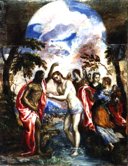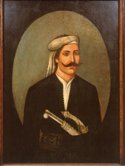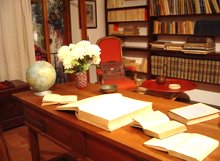Visitors begin their tour in the A.G. Kalokerinos Room, which presents an overview of Cretan history via representative exhibits from all the collections and chronological periods. The main exhibit is the 4 x 4 metre model of the city of Chandax (Heraklion) in the mid-17th century, at the peak of its power in Venetian times. Visitors can activate forty different spotlights picking out the most important monuments.
The Ceramics and Sculpture Collections, which follow, are organised in chronological order. Starting from the First Byzantine Period, the former ends in the Ottoman period and the latter in the Venetian period. Within this chronological layout there are individual thematic displays (locally-produced and imported ceramics; luxury and everyday ceramics; ecclesiastical and urban architecture; water supply etc.), which offer visitors additional information on the Cretan population's living conditions.
The Historical Museum's Numismatic Collection is particularly rich. Individual coin finds and hoards, banknotes, medals, lead seals, coin jewellery and relevant archive material chart all phases of Cretan economic history from the early Christian period to the 20th century.

Christ (1675) by Emmanouil Tzane Bounialis
|

The Baptism of Christ (1567) by Domenicos Theotocopoulos (El Greco)
|
In the
Byzantine and Post-Byzantine Collection visitors can follow the development of art (via fresco fragments and portable icons) and thus come to realise the dynamic co-existence of the native Christian Orthodox population with the Ottoman and Venetian overlords. Piety and Christian worship are manifested in liturgical vessels and vestments, manuscripts, personal belongings and jewellery. The crowning exhibits in this section are two paintings by
Domenicos Theotocopoulos (El Greco):
The Baptism of Christ (1567) and
View of Mt. Sinai and the Monastery of St. Catherine (1570), which are the only works by the artist on display on Crete.
Modern and contemporary Cretan history is divided into four chronological phases and permanent exhibitions, the first being Ottoman Rule, with emphasis on the Muslim presence on the island. This includes objects from secular and religious life (Ottoman wall paintings, inscriptions, architectural elements from Ottoman religious foundations, documents and minor objects). The second concerns the period of revolutionary upheaval in the 19th century, ending with the Union of Crete with Greece. Rich historical material traces revolutionary activity and everyday life at the time (flags, banners, weapons, documents, articles for everyday use, furniture, uniforms, maps, photographs). This section also includes a gallery of portraits of Cretan revolutionaries. The third exhibition relates to the Inter-War Years and the fourth to World War II (the war between Greece and Italy, the Battle of Crete and the National Resistance). Audiovisual material is used here in an attempt to recreate the environment during battles and bombardments. This section is supplemented by the study and library of Emmanouil Tsouderos, then Prime Minister of Greece.

Cretan resistance fighters during the German Occupation
|

Portrait of Michalis Mavroyiannis or 'Melitakas', rebel leader from Mylopotamos during the 1821-1830 uprising
|

The tour continues in the
Nikos Kazantzakis Rooms, with the author's study and library from his house in Antibes, France. Personal mementoes, manuscripts and first editions of his works in many languages complete the picture of his life and creativity.

Ending their tour of Cretan history in the
Ethnographic Collection, visitors are introduced to the notion of continuity in time, mainly in rural society, through the survival and repetition of productive processes (olive growing and viniculture, cereal cultivation, animal husbandry) and important milestones in life (birth, baptism, marriage). These human activities are closely bound up with the natural environment and space in which they take place (folk architecture - reconstructed interior of a Cretan agricultural house).
In and around
Show All
Tourism facilities
Regional interest
Towns & Villages
Sightseeing
Beaches